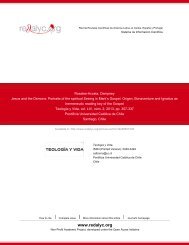A Key Concept in Modern Translation Theory - Redalyc
A Key Concept in Modern Translation Theory - Redalyc
A Key Concept in Modern Translation Theory - Redalyc
You also want an ePaper? Increase the reach of your titles
YUMPU automatically turns print PDFs into web optimized ePapers that Google loves.
74 EQUIVALENCE REVISITED: A KEY CONCEPT IN MODERN TRANSLATION THEORY<br />
“As a theoretic-descriptive concept equivalence designates the relation between a B<br />
text <strong>in</strong> language L2 (target language text, TL-text) and an A text <strong>in</strong> language L1 (source language<br />
text, SL-text) which allows us to speak of B as a translation of A. Equivalence is then understood<br />
as a basic, constitutive, translation concept. It is suitable for dist<strong>in</strong>guish<strong>in</strong>g translations from<br />
other forms of secondary text products (texts related to a primary or source text).” (p.11)<br />
“As a translation normative critical concept equivalence is used <strong>in</strong> the sense of<br />
sameness of value between a target text (translation) and a source text (orig<strong>in</strong>al text).<br />
Target language correspondences –from word to text level- are assessed. The optimal<br />
correspondence will be designated as equivalent, <strong>in</strong> contrast to non- or less-equivalent<br />
correspondences. This second use of the concept of equivalence belongs <strong>in</strong> the field of<br />
translation criticism and assessment. In the scientific discussion -as well as <strong>in</strong> the<br />
discussion between translation theorists and practitioners- the descriptive-theoretic and<br />
the normative-evaluative concepts of equivalence are often mixed up.” (Ibid) 9<br />
We do not agree fully with the above dist<strong>in</strong>ction of equivalence <strong>in</strong>to two<br />
different concepts. The theoretic-descriptive concept is essential for dist<strong>in</strong>guish<strong>in</strong>g<br />
a translation from other secondary products (e.g. adaptations, paraphrases,<br />
imitations, etc). However it is the same concept of equivalence which accounts<br />
for the relations between the SL and the TL texts <strong>in</strong> case we are describ<strong>in</strong>g and<br />
assess<strong>in</strong>g the way these relations have been established, that is, <strong>in</strong> translation<br />
criticism. Then our assumption is that as the concept of equivalence is dynamic<br />
it can be used for analyz<strong>in</strong>g both the process and the product of translation.<br />
Nonetheless, this should not mean that two concepts are be<strong>in</strong>g used; we would<br />
say <strong>in</strong>stead that the same concept is be<strong>in</strong>g employed for two different purposes.<br />
On the other hand, the usefulness of this constitutive concept of equivalence<br />
for dist<strong>in</strong>guish<strong>in</strong>g actual translations from other secondary l<strong>in</strong>guistic products (such<br />
as those result<strong>in</strong>g from a functionalistic-skopos approach) is stressed by the author:<br />
9<br />
“Als theoretisch-descriptiver Begriff bezeichnet Äquivalenz die Beziehung zwischen e<strong>in</strong>em<br />
Text B <strong>in</strong> Sprache L2 (zielsprachlicher Text, ZS-Text) und e<strong>in</strong>em Text A <strong>in</strong> Sprache L1<br />
(ausgangssprachlicher Text, AS-Text), die es erlaubt, von B als e<strong>in</strong>er Üebersetzung von A zu<br />
sprechen. Äquivalenz wird damit als übersetzungskonstituierender Grundbegriff verstanden. Er<br />
dient dazu, Übersetzung von anderen Formen der sekundären (auf e<strong>in</strong>en Primär- oder Ausgangstext<br />
textbezogen) Textproduktion zu unterscheiden.<br />
Als normativ-übersetzungskritischer Begriff wird Äquivalenz im S<strong>in</strong>ne von Gleichwertigkeit<br />
von Zieltext (Übersetzung) und Ausgangstext (Orig<strong>in</strong>altext) verwendet. Zielsprachliche<br />
Ensprechungen zu ausgangssprachlichen Übersetzungse<strong>in</strong>heiten –von der Wort bis zur Textebenewerden<br />
bewertet; die optimale Entsprechung wird als äquivalent bezeichnet, im Unterschied zu<br />
weniger oder nicht äquivalenten Entsprechungen. Diese zweite Verwendungsweise des<br />
Äquivalenzbegriffs gehört <strong>in</strong> den Bereich von Übersetzungskritik und –bewertung. In der<br />
wissenschaftlichen Diskussion –wie auch <strong>in</strong> der Diskussion zwischen Theoretikern und Praktikern<br />
der Übersetzung- wird allerd<strong>in</strong>gs häufig der deskriptiv-theoretische mit dem normativ-wertenden<br />
Begriff der Äquivalenz vermischt.”
















